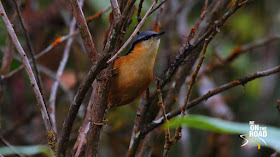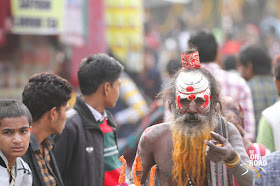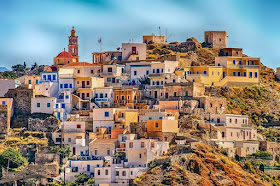
It is one of India’s best birding hotspots. It is an integral part of the elephant corridor in the Eastern Himalayas. One can see the most surreal sunrises of the Eastern Himalayas here. I am talking about the extremely off-beat and hidden Eaglenest Wildlife Sanctuary that is located in the Himalayan foothills of West Kameng district, Arunachal Pradesh.

Made up of sub-tropical forests, evergreen forests and bamboo forests, shrubs and thickets, the beauty of Eaglenest Wildlife Sanctuary lies in its wide altitude range (500 m to 3,250 metres). This diversity in altitude range gives birth to a wide variety of flora and which in turn attracts many birds, herpetofauna, mammals and butterflies. A part of the Kameng Elephant reserve, it conjoins Sessa Orchid sanctuary to the north-east and Pakhui Tiger Reserve across the Kameng river to the east.

It’s call to fame was a new bird species that was discovered here in 2006 by amateur birder and astrophysicist Ramana Athreya. This bird was named Bugun liocichla after the Bugun community that lives in this forest. But, for me, Eaglenest is more than just one bird. To me, it is surreal Himalayan sunrises, pristine Himalayan forests, colorful small birds, vibrant butterflies, giant flying squirrels, stories of marauding elephants and plenty of birding walks through bamboo thickets and forests.

With at least 454 species of birds here, birding is the major attraction here. If you are patient, you will spot birds that you will not come across anywhere in India except in the color palettes of birding books. Nuthatches, Pittas, Yuhinas, Milnas, Trogons and Sibias give you company as you make your daily walk through this forest. In addition to these small bird species, Eaglenest has the unique distinction of having three tragopan species. If you are lucky, you will spot giant flying squirrels, Arunachal Macaques, Gaurs and Elephants during your birding expeditions.

Apart from birding, one can study butterflies here, see rhododendrons during the spring season, see the vibrant fall colours in November, enjoy waking up to the sun rising over the snow capped mountains of the Himalayas or huddle around the campfire on chilly nights while listening to the stories of the land.

Eaglenest Wildlife Sanctuary is an absolute joy to the senses and a treat to the eyes. It doesn’t matter whether you are a birdwatcher, wildlife enthusiast, herpetologist, lepidopterist or a simple nature enthusiast, this remote wildlife sanctuary of Arunachal Pradesh will blow your mind with its riches. I recommend it with many thumbs up!

How to get inner line permit for Arunachal Pradesh:
If you have made prior bookings at either of the campsites at Eaglenest, they will help you get the inner line permit.
If you wish to get the permit on your own, you can either apply online at the government website or visit in-person to the Deputy Commissioner’s office at any of these cities - Delhi, Kolkata, Guwahati, Shillong, Tezpur, Dibrugarh, North Lakhimpur, Jorhat and in the capitals of other NE states.

How to reach there:
The nearest airport would be Tezpur (150 kms away), but the nearest airport with the best pan-India connectivity would be Guwahati (about 355 kms away or 9 hour drive).
The nearest railway station would be Bhalukpong (around 94 kms away).
If you are traveling by road, the best option would be to hire your own mode of transportation. The route would be Guwahati –> Tezpur –> Tenga –> Eaglenest campsite. The route from Tenga to Eaglenest campsite is usually in bad condition.
If you wish to opt for public transportation, you will have to make do with multiple bus and shared jeep rides till Tenga. After that, you will have to hire a vehicle to take you to Eaglenest campsite.

Best season to visit:
The rhododendron season of March and April are the best months to visit to see the birds. But, this is also high season and bookings need to be made well in advance.
If you don’t mind cold weather, mid-November through February is a great time to visit too. This is also the time when the mountain views are clearer and the sunrises are magnificent.
Eaglenest wildlife sanctuary is closed during the monsoon months of June through September.

Where to stay:
The only options to stay at Eaglenest Wildlife Sanctuary are at tented camps. Lama Birding camp,Bompu Camp and Sessni camp are such campsites run by the Bugun welfare society. Lama is the oldest camp. Both camps are basic, but offer fantastic location and views.

Where to eat:
There are no restaurants here. So the only place to eat is at your place of accommodation, which is bound to be basic. If you have any specific needs, it is best that you carry them with you.

Other nearby places for birdwatching:
1) Nameri National Park, Assam – about 113 kms away
2) Sela pass, Arunachal Pradesh – about 160 kms away
3) Manas National Park, Assam – about 275 kms away
4) Orang National Park, Assam – about 130 kms away
5) Kaziranga Tiger Reserve, Assam – about 135 kms away
6) Hoolongopar Gibbon Wildlife Sanctuary, Assam – about 290 kms away

Other nearby tourist attractions:
1) Sela Pass – A 13,000 feet high beautiful mountain pass in Western Arunachal Pradesh. Known for its high altitude lakes and winding roads.
2) Nameri National Park – Located at the foot hills of the Eastern Himalayas, this national park is home to tigers, elephants and the great hornbill. Also, its rivers were once famous for angling.
3) Bomdila – Home to the Bombila monastery, this Buddhist town can make for a great pit stop before heading towards Tawang.
4) Dirang – A scenic pit stop enroute to Tawang from Guwahati.
5) Sangti valley – This beautiful valley is known for its pristine forests, stunning mountain views, fast rivers, fruit orchards and interesting culture.
6) Tawang – A 10,000 feet high hill station that is home to the largest Buddhist monastery in India.
7) Jung Falls – A beautiful pit stop enroute to Tawang.
8) Kaziranga Tiger Reserve – A UNESCO World Heritage site and home to the one-horned rhinoceros. This Brahmaputra swampland is home to elephants, tigers, rhinos and many other wild animals.
9) Jaswantgarh war memorial – A war memorial commemorating the soldiers who fought in the 1962 Indo-China war.
10) Penga Teng Tso Lake – A beautiful high altitude lake north of Tawang towards the India – China border.
11) Tongpen La view point – An absolutely stunning view point enroute to Bumla pass.
12) Sangetsar Lake – A religious lake where many Bollywood movies have been shot.





















